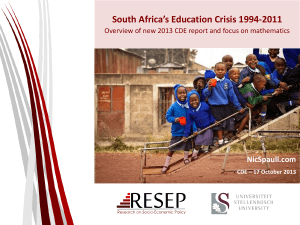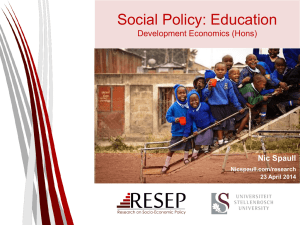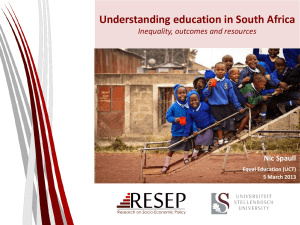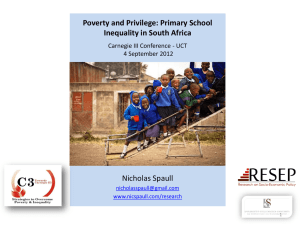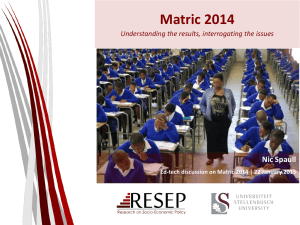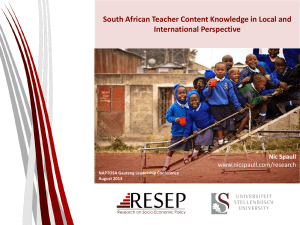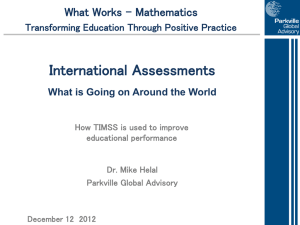Large Scale Quantitative Research on Education
advertisement
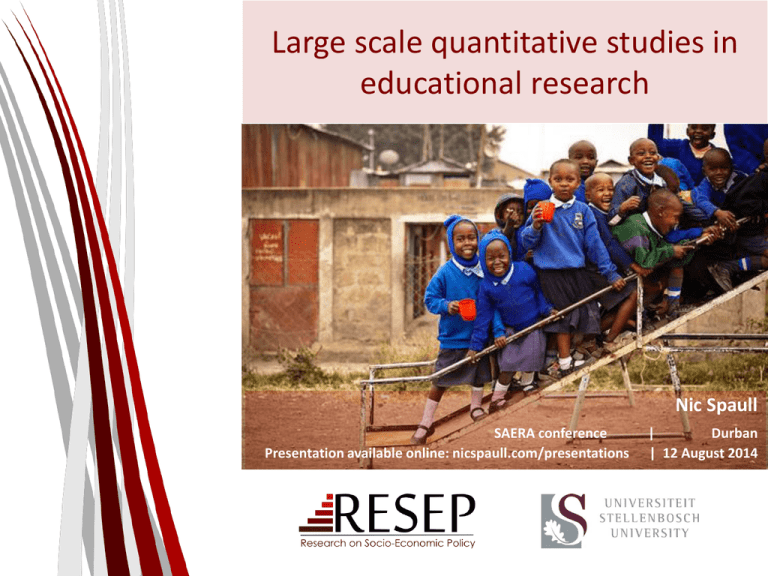
Large scale quantitative studies in educational research Nic Spaull SAERA conference Presentation available online: nicspaull.com/presentations | Durban | 12 August 2014 Objectives of the workshop • For participants to leave with… 1. A good idea of what large-scale data exist in SA and which assessments SA participates in. 2. To appreciate why we need them 3. Which areas of research are most amenable to analysis using quantitative data? (The focus here is on non-technical, usually descriptive, analyses of large-scale education data. There is obviously an enormous field of complex multivariate research using quantitative data. See Hanushek and Woessman, 2013) 1. What do we mean by “large-scale quantitative research”? 1. What the heck do we mean by “large-scale quantitative research” ? Firstly, what do we mean when we say “large-scale quantitative studies” – Large-scale: usually implies some sort of representivity of an underlying population (if sample-based) or sometimes the whole population. – There are two “main” sources of large-scale data in education 1. Assessment data and concomitant background info (PIRLS/TIMSS/SACMEQ/ANA/Matric/NSES) 2. Administrative data like EMIS, HEMIS, PERSAL etc.. – Quantitative: The focus is more on breadth than depth. • As an aside in the economics of education, qualitative research that uses numerical indicators for the 15 (?) schools it is looking at would not really be considered quantitative research. The focus is still qualitative. Personal reflections – please challenge me on these… Qualitative Number of schools Quantitative Usually a small number of schools (1- Usually a large number of schools 50?) selected without intending to be (250+) that may be representative of representative (statistically speaking) an underlying population or not Over-arching interest Depth over breadth Breadth over depth Can make populationwide claims? No. This is one of the major limitations. Yes. This is one of the major advantages Scope of research Numerical summaries of data Often quite broad but shallow (one Usually very specific getting detailed dataset might be analysed from a SLM information pertinent to the specific perspective, a content perspective, a research topic. resourcing perspective etc.) Less important More important 1. What are we talking about? A. Types of research questions that are amenable to quantitative research: – – – – – B. How many students in South Africa are literate by the end of Grade 4? What proportion of students have their own textbook? What do grade 6 mathematics teachers know relative to the curriculum? Which areas of the grade 9 curriculum do students battle with the most? How large are learning deficits in Gr3? Gr6? Gr9? Types of research questions that are LESS amenable to quantitative research: – Which teaching practices and styles promote/hinder learning? – Questions relating to personal motivation, school culture, leadership style etc. (all of which require in-depth observation and analysis) – All the ‘philosophical’ areas of research: what is education for? What is knowledge? Says who? Who should decide what goes into the curriculum? How should they decide? Should education be free? That being said, researchers do focus on some of “type-B” questions (nonphilosophical ones) using quantitative data – (and have often made important contributions) but the scope of questions is usually quite limited, but the breadth/coverage and ability to control for other variables often makes the analysis insightful 1. What are we talking about? • To provide one example. If we look at something like school leadership and management (SLM), there are various approaches to researching this including: – In-depth study of a small number (15) of schools (something like the SPADE analysis of Galant & Hoadley) – Using existing large-scale data sets to try and understand how proxies of SLM are related to performance. To provide some examples… The above analysis is taken from Gabi Wills (2013) The above analysis is taken from Gabi Wills (2013) Sample-based Censusbased Number of schools? Number of students? Comparable over time? TIMSS 1995, 1999, 2003, 2011 - 285 11969 Yes - 392 9071 Yes - 92 3515 Sort of 341 15744 NA - 2340 54 Sort-of ANA 2011/12/13/1 4 24 7mil Definitely not Cross-national studies SACMEQ 2000, 2007, 2013 of educational achievement PIRLS 2006, 2011 (Eng/Afr only) prePIRLS 2011 Systemic Evaluations 2004 (Gr6), 2007 (Gr3) National assessments (diagnostic) National assessments (certification) Verification-ANA 2011, 2013 (Gr 3 & 6) 2164 (125/ prov) NSES* Gr3 (2007) Gr4 (2008) Gr5 (2009) 266 24000 (8383 panel) 6591 about 550,000 - Matric No *Number of schools and students is for the most recent round of assessments Yes (+ longitudinal) Differences between national assessment and public exams Like TIMSS/PIRLS/S ACMEQ Like matric Source: Greaney & Kellaghan (2008) There are also other assessments which SA doesn’t take part in… School-based • PISA: Program for International Student Assessment [OECD] • ICCS: International Civic and Citizenship Education Study [IEA] Home-based • IALS: International Adult Literacy Survey [OECD] • ALLS: Adult Literacy and Life Skills Survey [OECD] • PIAAC: Programme for the International Assessment of Adult Competencies [OECD] For more information see: http://www.ierinstitute.org/ Source: IERI Spring Academy 2013 Source: IERI Spring Academy 2013 Source: IERI Spring Academy 2013 An aside on matrix sampling… Because one 1. 2. can only test students for a limited amount of time (due to practical reasons and cognitive fatigue), and because one cannot cover the full curriculum in a 2 hour test (at least not in sufficient detail for diagnostic purposes) It becomes necessary to employ what is called matrix sampling. • • • • • • If you have 200 questions that cover the full range of the maths curriculum you could split this into 20 modules of 10 questions. If a student can cover 40 questions in 2 hours then they can write 4 modules. Different students within the same class will therefore write different tests with overlapping modules. Matrix sampling allows authorities to cover the full curriculum and thus get more insight into specific problem-areas, something that isn’t possible with a (much) shorter test. TIMSS/PIRLS/PISA all employ matrix sampling. SACMEQ 2000 and 2007 did not employ matrix sampling (all children wrote the same test) but from 2013 I think they are doing matrix sampling as well. This highlights one of the important features of sample-based assessments: the aim is NOT to get an accurate indication of any specific child or specific school but rather some aggregated population (girls/boys/provinces/etc.) TIMSS 2007 Test Design Booklet 1 2 3 4 5 6 7 8 9 10 11 12 13 14 TIMSS 2007 Booklets Pos 1 Pos 2 Pos 3 Pos 4 M01 M02 S01 S02 S02 S03 M02 M03 M03 M04 S03 S04 S04 S05 M04 M05 M05 M06 S05 S06 S06 S07 M06 M07 M07 M08 S07 S08 S08 S09 M08 M09 M09 M10 S09 S10 S10 S11 M10 M11 M11 M12 S11 S12 S12 S13 M12 M13 M13 M14 S13 S14 S14 S01 M14 M01 The IEA/ETS Research Institute (www.IERInstitute.org) 11 PIRLS 2006 Test Design • • • • 10 passages; 5 literary & 5 informational 126 items; 167 score points Multiple-choice and constructed-response questions PIRLS Reader PIRLS 2006 Booklets 1 2 3 4 5 6 7 8 Part 1 L1 L2 L3 L4 I1 I2 I3 Part 2 L2 L3 L4 I2 I3 I1 The IEA/ETS Research Institute (www.IERInstitute.org) 9 10 11 12 R I4 L1 I2 L3 I4 L5 I4 L1 I1 L2 I3 L4 I5 13 Sample-based assessments (cont.) • The aim of sample-based assessments is to be able to gain insight (and make statements) that pertain to an underlying population AND NOT the sampled schools. • For example in SACMEQ the sample was drawn such that the sampling accuracy was at least equivalent to a Simple Random Sample of 400 students which guarantees a 95% confidence interval for sample means that is plus or minus 1/10th of a student standard deviation (see Ross et al. 2005). – This is largely based on the intra-class correlation coefficient (ICC) which is a measure of the relationship between the variance between schools and within schools. – In South Africa this meant we needed to sample 392 schools in SACMEQ 2007 • Important to understand that there are numerous sources of error and uncertainty, especially sampling error and measurement error. Consequently one should ALWAYS report confidence intervals or standard errors. Sample-based assessments (cont.) • Once you know the ICC and therefore the number of schools you need to sample, you need a sampling frame (i.e. the total number of schools). • One can also use stratification to ensure representivity at lower levels than the whole country (i.e. province or language group) • Randomly select schools from sampling frame. • For example, for the NSES 2007/8/9…. Brown dots = former black schools Blue dots = former white schools Purple dots = school included in NSES (courtesy of Marisa Coetzee) What kinds of administrative data exist? • Education Management Information Systems (EMIS) – Annual Survey of Schools – SNAP – LURITZ. System aimed at being able to identify and follow individual learners using unique IDs – SA-SAMS • • • • • HEMIS – EMIS but for higher education PERSAL – payroll database School Monitoring Survey Infrastructure survey ECD Audit 2013 Overview • Main educational datasets in South Africa: • • • • • • • • • PIRLS TIMSS 1995 1999 SACMEQ 2000 V-ANA ANA NSES EMIS (various) Matric (annual) Household surveys (various 2006 2002 2011 2011 2007 2013 2011 2011 2012 2007 2008 2009 • When and Who: • • • PIRLS 2006 (grade 4 and 5) PIRLS* 2011 (grade 5 Eng/Afr only) prePIRLS (grade 4) Examples of how we can use it? • • • Issues related to LOLT Track reading performance over time International comparisons .004 .003 .001 0 • Progress in International Reading and Literacy Study Tests the reading literacy of grade four children from 49 countries Run by CEA at UP on behalf of IEA (http://timss.bc.edu/) 0 200 400 reading test score 600 800 English/Afrikaans schools African language schools 600 prePIRLS reading score 2011 • .002 What: kdensity reading test score PIRLS .005 PIRLS 2006 – see Shepherd (2011) 560 576 531 525 520 480 440 452 443 436 429 428 425 461 463 407 400 395 388 360 320 280 240 Test language prePIRLS 2011 – see Howie et al (2012) PIRLS South Africa 2006 Grade 4 11 Languages Grade 5 11 Languages PIRLS South Africa 2011 prePIRLS PIRLS Grade 4 Grade 5 11 Languages Afrikaans English Afrikaans English isiNdebele isiXhosa isiZulu prePIRLS 2011 Grade 4 Sepedi Sesotho Setswana siSwati Tshivenda Xitsonga PIRLS 2011 Grade 5 Afrikaans English prePIRLS 2011 Benchmark Performance by Test Language 47 Xitsonga 53 53 Tshivenda 47 24 siSwati 0 0 76 0.25 Setswana 34 66 0.1 Sesotho 36 64 0.1 57 Sepedi 43 29 isiZulu 71 38 isiXhosa 0.8 0.4 62 31 isiNdebele 0 69 0.2 English 10 90 19 Afrikaans 12 88 15 South Africa 29 Did not reach High International Benchmark 71 6 Low International benchmark Advanced International benchmark Intemediate International Benchmark .008 TIMSS 2003 Maths – see Taylor (2011) • When and Who: • • • TIMSS 1995, 1999 (grade 8 only) TIMSS 2002 (grade 8 and 9) TIMSS 2011 (grade 9 only) Examples of how we can we use it? • • • Interaction between maths and science Comparative performance of maths and science achievement Changes over time .004 0 0 200 400 Grade 8 mathematics score South Africa Quintile 5 Chile Quintile 5 Singapore Quintile 5 600 800 Chile Singapore 600 560 520 480 440 400 360 320 280 240 200 Middle-income countries TIMSS 2011 Science – see Spaull (2013) Quintile 1 Quintile 2 Quintile 3 Quintile 4 Quintile 5 Independent • Trends in International Mathematics and Science Study Tests mathematics and science achievement of grade 4 and grade 8 pupils Run by HSRC in SA on behalf of IEA (http://timss.bc.edu/) Russian Federation Lithuania Ukraine Kazakhstan Turkey Iran, Islamic Rep. of Romania Chile Thailand Jordan Tunisia Armenia Malaysia Syrian Arab Republic Georgia Palestinian Nat'l Auth. Macedonia, Rep. of Indonesia Lebanon Botswana (Gr 9) Morocco Honduras (gr 9) South Africa (Gr 9) Ghana • .002 What: TIMSS 2011 Science score Density .006 TIMSS South Africa (Gr9) TIMSS 2011 South African mathematics and science performance in the Trends in International Mathematics and Science Study (TIMSS 1995-2011) with 95% confidence intervals around the mean (Spaull, 2013) 480 440 400 360 TIMSS score 320 280 240 352 160 120 443 433 200 276 275 264 285 1995 1999 2002 2002 332 260 243 244 268 1995 1999 2002 2002 80 40 0 Grade 8 2011 Grade 9 TIMSS Mathematics 2011 TIMSS middleincome country Gr8 mean Grade 8 2011 Grade 9 TIMSS Science 2011 TIMSS middleincome country Gr8 mean .0 08 SACMEQ III – see Spaull (2013) • • Southern and East African Consortium for Monitoring Educational Quality Tests the reading and maths performance of grade six children from 15 African countries Run by DBE – Q.Moloi (http://www.sacmeq.org/) 0 • .0 02 What: .0 04 D en sity .0 06 SACMEQ 0 Mean 950 • • • 900 SACMEQ II – 2000 (grade 6) SACMEQ III – 2007 (grade 6) SACMEQ IV – 2013 (grade 6) Examples of how can we use it? • • • Regional performance over time Teacher content knowledge Understanding the determinants of numeracy and literacy Maths-teacher mathematics score When and Who: 200 800 Poorest 25% Second poorest 25% Second wealthiest 25% Wealthiest 25% Lower bound confidence interval (95%) 1000 Upper bound confidence interval (95%) KEN 850 ZIM UGA TAN SEY SWA BOT NAM MALSOU LESZAMMOZ 800 750 700 650 400 600 Learner Reading Score Q5-SOU Q4-SOU Q3-SOU Q2-SOU Q1-SOU ZAN 600 SACMEQ III – see McKay & Spaull (2013) SACMEQ III (Spaull & Taylor, 2014) ANA – see Spaull (2012) School Categorisation by District (KZN) ANA 60 40 0 20 P ercent 80 100 Universal ANA 2011 What: • • • OB Annual National Assessments Administrative data on enrolments, staff, schools etc. Collected by DBE ON JE NI VR YH E ID S IS ON I N KE LA EN OW KE NG ET HU PA P IN OT EM IL E MB E AM PO AJ RT UB A E SH PS TO I U TH OV YA DL Z IN UN G UM UN G UM NE Dysfunctional schools: <30% Underperforming schools: 30-40% Poor schools: 40-50% Good schools: 50-60% Great schools: 60-70% Excellent schools: 70%+ Correlation Between Avg. School Gr3 and Gr6 Numeracy Score (KZN) interview) 1 00 80 60 40 20 0 20 40 60 80 Average school grade 6 numeracy score Correlation Between Avg. School Gr3 and Gr6 Numeracy Score (WC) 1 00 U-ANA 2011 0 • • • 0 80 • • Analyse performance at primary grades, potentially at the micro-level (district/circuit) Create indicators for dashboards Report cards (once ANA is externally evaluated at one grade) Early indicators of problems/deficits Planning at primary school level Serious comparability problems between ANA 2011 and ANA 2012 (see SVDB and Spaull S cho ol a ve ra ge g ra de 3 nu m e racy score • 60 Examples of how can we use it? 40 Grades 1-6 and 9 (maths and language - FAL and HL) 20 A verag e scho ol g rad e 3 n um e ra cy sco re • LA School categorization (Average school numeracy and literacy score) U-ANA 2011 When and Who: UM 0 20 40 School average grade 6 numeracy score 60 80 ZI ANA Language by grade/quintile (KZN) Race Distribution by Quintile (KZN) U-ANA 2011 100% 90% 80% 70% 60% 50% 40% 30% 20% 10% 0% 1 3 3 1 14 11 8 3 100 100 98 Other Asian Indian 91 White 65 Coloured Black Q1 Q2 Q3 Q4 Q5 Correlation 0.82 Correlation 0.51 EMIS – see Taylor (2012) 1200000 EMIS 1000000 800000 600000 What: • • • 400000 Education Management Information System Administrative data on enrolments, staff, schools etc. Collected by DBE (http://www.education.gov.za/EMIS/tabid/57/ Default.aspx) 200000 0 grade 10 The ratio of grade 2 enrolments ten years prior to matric to matric passes by province When and Who: • Various Examples of how can we use it? • • Analyse flow-through Create indicators for dashboards – • • Grade 12 PTR, school size, LOLT etc Provide an up-to-date and accurate picture of elements of the education system Planning EMIS – see Taylor (2012) “In 1999 and 2000 the numbers enrolling in grade 1 dropped substantially, by about half a million. Crucially, it is these cohorts who make up the bulk of the matric class of 2011. This was due to a change in the policy stipulating age of entry into grade 1. According to Notice 2433 of 1998, it was stipulated that children should only be allowed to enrol in grade 1 if they turned seven in that calendar year. Therefore children who previously might have entered in the year in which they turned six were now not allowed to. The policy change was announced in October 1998 and schools were expected to comply by January 2000. This would explain why grade 1 enrolments declined somewhat in 1999 and then again even more so in 2000. The reason why numbers declined as the policy was phased in is that some children who turned 7 in the 2000 calendar year had already entered in the previous year under the previous policy. “ - Taylor 2012 EMIS – see Taylor (2012) Matric Grade 10 (2 years earlier) Grade 12 Those who pass matric Pass matric with maths 1200000 60% 1000000 50% 800000 40% 600000 30% 400000 20% 200000 10% • • • Grade 12 examinations results Performance data Collected by DBE When and Who: • Various Examples of how can we use it? • • Analyse subject choices/combinations Create indicators for dashboards – – • • Number of students What: 0 0% Matric 2008 Matric 2009 Matric 2010 Matric 2011 (Gr 10 2006) (Gr 10 2007) (Gr 10 2008) (Gr 10 2009) % taking maths/science Proportion of Gr 8’s passing matric Relatively trustworthy and regular indication of student outcomes in SA. Planning EMIS – see Taylor (2012) Proportion of matrics (%) Proportion of matrics taking mathematics Household Surveys What: • • • Grade 12 examinations results Performance data Collected by DBE When and Who: • Various Examples of how can we use it? • • Research Link education to other social outcomes like employment and health HH-Surveys – see Taylor (2012) Household Surveys Employment/LFA Rate for 18 - 24 -year -olds Percentage of youth in employment by highest educational attainment (Van Broekhuizen, 2013) 80% 70% 60% 50% 40% 30% 20% 10% All Youth Youth with Less than Matric With Matric Youth With Diploma Youth With Degree 2011 2010 2009 2008 2007 2006 2005 2004 2003 2002 2001 2000 1999 1998 1997 1996 Working-Age Population 100% 80% 60% 40% 20% With Less Than Matric With Matric With Diploma 2011 2010 2009 2008 2007 2006 2005 2004 2003 2002 2001 2000 1999 1998 1997 1996 0% 1995 Proportion of youth with Qualification 1995 0% With Degree Composition of 18 - 24-year-olds by highest level of education completed (Van Broekhuizen, 2013) Some other research… (Discuss if time permits) .005 Kernel Density of Literacy Score by Race (KZN) .0 06 .0 04 D en sity .003 .0 02 .002 .0 1 0 0 0 .0 05 .001 .0 15 kdensity reading test score .004 .0 2 U-ANA 2011 D en sity .0 08 Context: low and unequal learner performance 0 20 40 60 Literacy score (%) 80 0 100 0 Black White Indian Asian 200 400 reading test score 600 200 English/Afrikaans schools African language schools 400 600 Learner Reading Score 800 800 Poorest 25% Second poorest 25% Second wealthiest 25% Wealthiest 25% 1000 .025 PIRLS / TIMSS / SACMEQ / NSES / ANA / Matric… by Wealth / Language / Location / Dept… Kernel Density of School Literacy by Quintile .0 1 .0 2 D e n s ity .015 .01 0 0 .005 Density .0 3 .02 .0 4 U-ANA 2011 0 0 20 40 60 Numeracy score 2008 Ex-DET/Homelands schools 80 Historically white schools 100 20 40 60 Average school literacy score 80 Quintile 1 Quintile 2 Quintile 3 Quintile 4 100 Quintile 5 47 Comparing WCED Systemic Evaluation and DBE ANA WC 2011 Quantifying learning deficits in Gr3 Figure 1: Kernel density of mean Grade 3 performance on Grade 3 level items by quintiles of student socioeconomic status (Systemic Evaluation 2007) .01 .01 5 .02 16% 51% .00 5 K e rn el d e nsity o f G ra d e 3- le vel s core s .02 5 (Grade-3-appropriate level) 11% 0 Only the top 16% of grade 3 students are performing at a Grade 3 level 0 10 20 30 40 50 60 70 80 90 Systemic 2007 Grade 3 mean score (%) on Grade 3 level items Quintile 5 • (Spaull & Viljoen, 2014) Quintile 1-4 Following Muralidharan & Zieleniak (2013) we classify students as performing at the gradeappropriate level if they obtain a mean score of 50% or higher on the full set of Grade 3 level questions. 49 NSES question 42 NSES followed about 15000 students (266 schools) and tested them in Grade 3 (2007), Grade 4 (2008) and Grade 5 (2009). Grade 3 maths curriculum: “Can perform calculations using appropriate symbols to solve problems involving: division of at least 2-digit by 1-digit numbers” 100% Even at the end of Grade 5 most (55%+) quintile 1-4 students cannot answer this simple Grade-3-level problem. 90% 35% 80% 70% 59% 57% 57% 55% 60% 50% 40% 13% 14% 14% 15% 20% 13% 10% 12% 12% 10% 16% 19% 17% 17% Q1 Q2 Q3 Q4 30% 13% Still wrong in Gr5 14% Correct in Gr5 Correct in Gr4 Correct in Gr3 39% 0% “The powerful notions of ratio, rate and proportion are built upon the simpler concepts of whole number, multiplication and division, fraction and rational number, and are themselves the precursors to the development of yet more complex concepts such as triangle similarity, trigonometry, gradient and calculus” (Taylor & Reddi, 2013: 194) Q5 Question 42 (Spaull & Viljoen, 2014) 50 Insurmountable learning deficits: 0.3 SD South African Learning Trajectories by National Socioeconomic Quintiles Based on NSES (2007/8/9) for grades 3, 4 and 5, SACMEQ (2007) for grade 6 and TIMSS (2011) for grade 9) 13 12 11 10 Effective grade 9 8 Quintile 1 7 Quintile 2 6 Quintile 3 5 Quintile 4 4 Quintile 5 Q1-4 Trajectory 3 Q5 Trajectory 2 1 0 Gr3 Gr4 Gr5 (NSES 2007/8/9) Gr6 (SACMEQ 2007) Gr7 Gr8 Projections Gr9 (TIMSS 2011) Gr10 Gr11 Gr12 Projections Actual grade (and data source) (Spaull & Viljoen, 2014) 51 Data and analysis • In order to answer research questions and engage with the data requires some level of analytic proficiency with a statistical software package like STATA or SPSS (or R if you are hardcore) • Education faculties in South Africa really need to up their game as far as quantitative analysis is concerned. For whatever reason there seems to be an anti-empirical, anti-quantitative bias across the board. This filters through into course-load priorities and expectations (or lack of expectations) on graduate students. • Without an ability to interact with a large data set and do BASIC data analysis any graduate student’s research opportunities are severely (and unnecessarily) limited (the same applies to faculty members) • SALDRU (UCT) runs a free online STATA course to teach the basics of data analysis – – http://www.saldru.uct.ac.za/training/online-stata-course There is also a two-week ”UCT Summer training Programme in Social Science research Using Survey Data” run in January every year and well worth going to if you already have a basic background in statistics Conclusion • Data is essential for making informed decisions • To be able to use these data sets requires some level of analytic proficiency. Basic proficiency can take as little as 4 months but is infinitely valuable. • Nationally representative datasets allow us to draw conclusions for each province and the whole country – something that is not possible from small local studies. • DBE has access to a wealth of useful but under-utilized data – ANA, EMIS, MATRIC, HH-SURVEYS (also PERSAL & SYSTEMIC) • Many datasets are publicly available on request – SACMEQ, TIMSS, PIRLS (SACMEQ 2013 soon to be available) • “Without data you are just another person with an opinion” – Andreas Schleicher References and useful websites • • • • • • • • Fleisch, B. (2008). Primary Education in Crisis: Why South African Schoolchildren underachieve in reading and mathematics (pp. 1–162). Cape Town: Juta & Co. Greaney, V., & Kellaghan, T. (2008). Assessing national achievement levels in education (Vol. 1). World Bank Publications. Reddy, V., Prinsloo, C., Visser, M., Arends, F., Winnaar, L., & Rogers, S. (2012). Highlights from TIMSS 2011: The South African perspective. Pretoria. Ross, K. N., Dolata, S., Ikeda, M., Zuze, L., & Murimba, S. (2005). The Conduct of the SACMEQ II Project in Kenya. Harare. Taylor, N., Van der berg, S., & Mabogoane, T. (2013). What makes schools effective? Report of the National School Effectiveness Study. Cape Town: Pearson. Taylor, S., & Yu, D. (2009). The importance of socioeconomic status in determining educational achievement in South Africa (No. 1). Stellenbosch. Van der berg, S., Burger, C., Burger, R., De Vos, M., Du Rand, G., Gustafsson, M., … Von Fintel, D. (2011). Low quality education as a poverty trap. Stellenbosch. http://www.sacmeq.org/ www.oecd.org/pisa http://timssandpirls.bc.edu Group exercise • Last 45 minutes – Split into groups of 5 (8 groups) – Using questionnaires provided, come up with at least 5 research questions that could (potentially) be answered using that data 1. 2. 3. Explain which variables you would use and how (what would the graph/table look like or be populated with? Sketch the axes) Why did you choose those research questions? Which other large-scale data do you think you could look at to further investigate the issue? Thank you www.nicspaull.com/research nicholasspaull@gmail.com @NicSpaull Difference between TIMSS & PISA Difference between TIMSS & PISA
